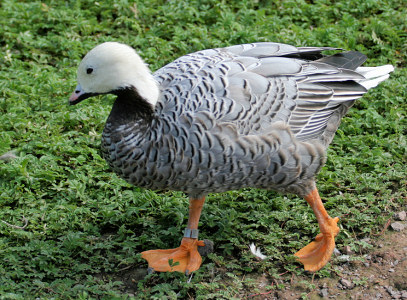Appearance: - The Emperor Goose has a white head and neck, black chin and throat, short beak which is pink on top, black below, and bluish around the nostrils with white tip, the stout body is bluish-grey which is subtly barred, and the tail is white. Legs and feet are an orange-yellow colour. Both sexes are alike.
Size: - Typical Adult is about 68cm (27in).
Food: - Eelgrass, seaweed, algae, sea lettuce, berries, also grazes on grasses, and will feed on molluscs and crustaceans.
Habitat/Range: - Salt marshes, tundra meadows, flat grasslands, mudflats and coast in north-east Siberia, and Alaska around the Bering Sea. Winters mainly in the Aleutian Islands.

 Breeding Habitat/Resident,
Breeding Habitat/Resident,  Migration or Winter Area.
Migration or Winter Area.Breeding Season: - Begins late May to June.
Eggs: - 3 to 7 (creamy-white colour).
Notes: - The Emperor Goose belongs to the chen genus (White Geese). Although these geese are considered low risk at present, numbers have decreased. They are vulnerable to hunting and due to their limited range are at risk to local catastrophic events such as oil spills.
Conservation status (IUCN 3.1):
Near Threatened.
Classification - Family: Anatidae,
Subfamily: Anserinae, Genus: Chen.



















